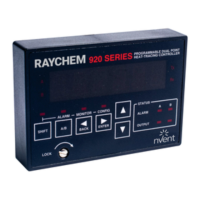56 / 82
EN- Raychem920series-IM-H5687405/15
INDUSTRIAL HEAT TRACING SOLUTIONS
6.3 COMMON ALARMSWHAT TO LOOK FOR
Alarm Description Cause of Alarm
High TS 1/TS 2
Temperature
Appears when the temperature exceeds the
HIGH TS ALARM
• Alarm temperature setting too close to maintain
temperature
• Flow of hot product
• Steaming out lines
• Incorrect tracer wiring
• IncorrectRTDTYPEselected
Low TS 1/TS 2
Temperature
Appears when the temperature decreases
below the LOW TS ALARM temperature.
• Alarm temperature setting too close to maintain
temperature
• Flow of cold product
• Empty pipe
• Damaged, wet, or missing insulation
• Heating cable not sized properly for the application
• Heating cable damaged
• IncorrectRTDTYPEselected
TS 1/TS 2 Failure Indicates that a sensor is operating
improperly.
• Incorrect or damaged field wiring—open leads or excess
resistance, either intermittent or continuous, may be
due to broken or damaged wires or loose terminals
• Damaged or inoperative temperature sensors
Control TS Failure Alarms a failure of the temperature-sensing
element designated as the control element by
the TS CONTROL MODE setting. Depending
on the chosen TS FAIL MODE and TS
CONTROL MODE, the output switch may be
latched off or on until this failure is corrected.
• Incorrect or damaged field wiring—open leads or
excess resistance, either intermittent or continuous,
may be due to broken or damaged wires or loose
terminals
• Damaged or inoperative temperature sensors
High Current Alarms current levels that are greater than
the HIGH CURRENT ALARM setting for the
application.
• Alarm setting too close to normal operating
• High in-rush current from cold start of
self-regulating cable
• Damaged or partially shorted heating cable
• “As built” cable length is greater than design value
• Incorrect CURRENT TURNS RATIO setting
Low Current Alarms current levels that are less than the
LOW CURRENT ALARM setting
• Alarm setting too close to normal operating current
• Low source voltage
• Damaged or inoperative heating cable
• Open connection—wiring problem, SSR or contactor
failed open
• Incorrect CURRENT TURNS RATIO setting
High GFI Alarms ground-fault current levels that are
greater than the HIGH GFI ALARM setting
• Alarm setting too close to normal leakage current
• Damaged cable insulation and/or moisture present
• Moisture in junction box
• Poor splice or termination
• Moisture provides conductive ground path that allows
ground-fault current
GFI Trip This value sets the upper limit of allowable
ground-fault leakage. Exceeding this link
results in the output switch being latched off
and the alarm activated to indicate a ground-
fault condition.
• Trip setting too normal leakage current
• Damaged cable insulation and/or moisture present
• Moisture in junction box
• Poor splice or termination
• Moisture provides conductive ground path that allows
ground-fault current

